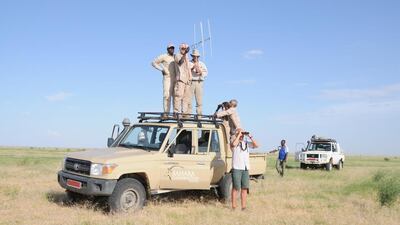Abu Dhabi Environment Agency releases 25 UAE-bred oryx to the grasslands of Chad, reversing their extinction in the African wild.
ABU DHABI // The scimitar-horned oryx has been brought back from extinction in the wilds of Chad thanks to the late Sheikh Zayed and the Abu Dhabi Environment Agency.
Repopulating the oryx, believed to have been poached to extinction in the wild 25 years ago, was one of the conservation passions of the UAE’s Founding Father.
As part of Ead’s reintroduction programme, 25 oryx bred in captivity in the UAE were released in the central African country and are being monitored by the Sahara Conservation Fund to see how they adapt to life in the wild.
“There have been no sightings for more than 25 years due to unregulated hunting, loss of habitat and lack of resources for conservation,” said Razan Al Mubarak, secretary general of Ead.
“Leading the programme, which endeavours to reinstate a viable population of this majestic creature in its home range of Chad, is a dream come true.”
The project will build a self-sustaining population by releasing between 300 and 500 oryx over the next five years.
The International Union of the Conservation of Nature listed the scimitar-horned oryx as extinct in the wild in 2000, although they are believed to have disappeared 10 years befoe that.
Since then, the animal, which naturally roams the sub-Saharan grasslands of Africa, from Senegal to Sudan, existed only in private collections.
One such collection was Sheikh Zayed’s oryx herd, which he decreed be protected in a wildlife reserve during his rule.
Ead’s task was to help transfer the oryx population, which today numbers 3,000 specimens, back to their endemic habitat.
However, animal breeds kept in captivity suffer from low diversity in the gene pool as a result of generational inbreeding.
Before Ead could consider reintroducing these oryx into the wild, they had to engineer what the organisation refers to as a “world herd”.
To help make the genetic pool more robust, animals from scimitar-horned oryx herds from around the world were brought to the UAE to breed. As a result, the released animals come from Ead’s world herd of oryx, including animals from the US, Europe and the UAE.
“This is an epic homecoming for this majestic species and a significant step forward for wildlife conservation,” said Steve Monfort, the director of the Smithsonian Conservation Biology Institute, in Virginia, US.
“This project was designed to give scimitar-horned oryx that chance, while also helping restore this grasslands ecosystem and to inspire similar reintroduction efforts for other species.”
Along with the Zoological Society of London, the teams fitted the 25 animals with GPS collars.
The data collected will help reintroduction programmes around the world.
“This dataset is gold to any conservation researcher,” said SCBI postdoc Jared Stabach.
“We’re essentially opening up a window that will help us to understand how and why individuals move across the landscape, and allow us to monitor each individual in a way that was never before possible.”
The animals have been in Chad since March, but were kept in pens to monitor their acclimatisation and adaptation to the Sahelian grassland before being released into the 77,000-square-kilometre reserve.
Initial reports show a group of 19 animals have ranged more than 30km from the release site, to an area green with vegetation and water. They are alert, healthy, calm and acclimatising to their new surroundings.
nalwasmi@thenational.ae

